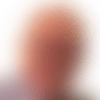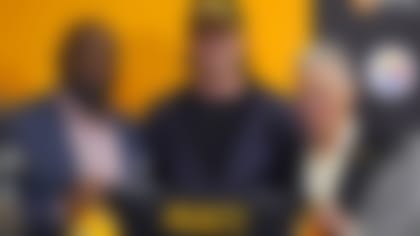Immediate draft grades provide a foundation for future evaluations. Waiting three years to assess draft classes without accounting for how the decision was viewed at the time usually leads to revisionist history.
These 2025 NFL Draft snap grades reflect the value I think each pick (or set of picks) has, given the slot and the prospect's college film/athleticism scores. Trades, and the capital exchanged (both picks and players), are factored into these grades, too, as they also play a significant part in determining the future of a franchise.
Round 2 (No. 47): CB Will Johnson, Michigan
Round 3 (No. 78): Edge Jordan Burch, Oregon
Analysis:
- Johnson's value in the middle of the second round was worth the risk, even with NFL Network Insider Ian Rapoport’s reporting on his knee issue. If healthy, he'll be a feisty zone corner with good ball skills.
- Burch was a nice find in the third round. He possesses the size to be a presence in the run game and the quickness to get to the quarterback.
Round 3 (No. 96): S Xavier Watts, Notre Dame
Analysis:
- The Falcons had no second-round pick after trading up for edge rusher James Pearce Jr. on Thursday night, but they filled one of their primary needs by drafting Watts. He reads quarterbacks and routes very well, which helps him take the ball away. He’s also a good tackler and should start from Day 1.
- The Falcons traded a 2025 third-round pick to the Patriots last August for edge rusher Matthew Judon, who posted 5.5 sacks in 17 games last season. I have to think they were hoping for a bit more out of that deal.
Round 2 (No. 59): Edge Mike Green, Marshall
Round 3 (No. 91): OT Emery Jones Jr., LSU
Analysis:
- Green went lower than many expected, potentially for off-the-field reasons. There’s little doubt about his on-field talent. He's not the biggest edge rusher, but he gets past offensive tackles with bend, quickness and the occasional bull rush move.
- Jones was announced as a tackle on Friday night and looked more athletic during NFL Scouting Combine drills than I expected. He also has the versatility to make the move inside to guard if needed.
Round 2 (No. 41): DT T.J. Sanders, South Carolina
Round 3 (No. 72): Edge Landon Jackson, Arkansas
Analysis:
- The Bills traded up in Round 2 to pick Sanders. He was selected a bit earlier than I expected, but the aggressive move could pay off if he becomes a consistent thorn in the side of offenses as an interior pass rusher.
- I pushed Buffalo’s grade down a bit because of the trade for receiver Amari Cooper, which cost them a 2025 third-round pick and did not pay off as hoped (20 receptions, 2 TDs in 8 games).
- Jackson was a nice value in Round 3 with a pick acquired from the Bears in the move for Sanders. His length and power make him a perfect fit for Buffalo.
Round 2 (No. 51): Edge Nic Scourton, Texas A&M
Round 3 (No. 77): Edge Princely Umanmielen, Mississippi
Analysis:
- Carolina traded up for Scourton and Umanmielen, getting ahead of a few teams that might have been targeting those players. Scourton brings power and Umanmielen bend off the edge, meeting the team's need to improve a pass rush for a defense that was historically poor last season. They did not have to pay a huge price to move up for those defenders.
Round 2 (No. 39): WR Luther Burden III, Missouri
Round 2 (No. 56): OT Ozzy Trapilo, Boston College
Round 2 (No. 62): DT Shemar Turner, Texas A&M
Analysis:
- Chicago selected Burden with a second-round choice acquired from the Panthers in their trade for the No. 1 overall pick back in 2023. The former Missouri receiver did not post elite numbers on the field last fall or at the combine, but he’s a tough after-the-catch creator with strong hands in the Deebo Samuel mold.
- The Bears made a nice trade in the second round, moving down 15 spots and bolstering their middle-round draft capital. After the deal, they landed Trapilo, a solid right tackle with experience on the left side. His stiff hips could be an issue against better defenders, but the draft's shallow depth at tackle pushed him up the board.
- Turner's quick-twitch ability won over the Bears despite his limited productivity at Texas A&M. We'll see if he can outperform a former Day 2 pick inside, Zacch Pickens.
Round 2 (No. 49): LB Demetrius Knight Jr., South Carolina
Round 3 (No. 81): OG Dylan Fairchild, Georgia
Analysis:
- Knight is an attacking, reliable player but he was selected earlier than I expected. This year’s class is not deep with top-notch linebackers, which might have pushed him up the board.
- Cincinnati had to find another interior offensive lineman early in this draft. Fairchild has the strength, intelligence and agility to play guard or center at the next level.
Round 2 (No. 33): LB Carson Schwesinger, UCLA
Round 2 (No. 36): RB Quinshon Judkins, Ohio State
Round 3 (No. 67): TE Harold Fannin Jr., Bowling Green
Round 3 (No. 94): QB Dillon Gabriel, Oregon
Analysis:
- Schwesinger will be a leader and secure tackler for the Browns’ defense. I had several other available players rated more highly, but in a weak linebacker class, I can’t argue much with the decision.
- Clearly, the Browns wanted a power back with an open-field burst, picking Judkins over his Ohio State teammate TreVeyon Henderson.
- Fannin's not an elite athlete, but the nation's leading receiver last fall has a chance to be a nice safety valve.
- Cleveland added Gabriel with the third-round pick it acquired from Buffalo in the Amari Cooper trade. I thought he was a top-120 value as an experienced quarterback who throws a catchable, tight spiral.
Round 2 (No. 44): Edge Donovan Ezeiruaku, Boston College
Round 3 (No. 76): CB Shavon Revel Jr., East Carolina
Analysis:
- Ezeiruaku is a pure pass rusher with very good quickness and a devastating spin move. I believe he's the next Demarcus Lawrence.
- The Cowboys found a bargain in Revel, as well. I know he’s coming off an ACL tear, which is why he was still available in Round 3, but he has pro-caliber size and the ability to make plays on the football.
Round 2 (No. 60): RB RJ Harvey, UCF
Round 3 (No. 74): WR Pat Bryant, Illinois
Round 3 (No. 101): Edge Sai'vion Jones, LSU
Analysis:
- The Broncos were very active in the trade market on Day 2, picking Harvey after moving down a few spots. He lacks elite size but runs through contact and can be a threat as a pass catcher out of the backfield. I had a higher grade on Iowa RB Kaleb Johnson, who was still available at the time.
- In my view, Denver reached a bit for Bryant. He has reliable hands, but his 4.61-second 40-yard dash at the combine did not impress me.
- The Broncos didn't give up a lot to move up for Jones later in Round 3. He could be an effective 5-technique or set up wide, depending on the alignment.
Round 2 (No. 57): OG Tate Ratledge, Georgia
Round 3 (No. 70): WR Isaac TeSlaa, Arkansas
Analysis:
- The loss of Kevin Zeitler in free agency pushed the Lions to grab Ratledge in the second round. The 6-foot-6 mauler plays with surprising leverage for his size and brings the attitude the Lions desire up front.
- Detroit gave up two 2026 third-round picks for a couple of sixth-rounders this year to trade up for TeSlaa, an athletic and intelligent pass catcher. Clearly, the Lions are willing to give up picks and jump the board for their guys. We'll see if TeSlaa turns out to be significantly better than Jaylin Noel, Savion Williams, Tai Felton and other receivers who were available at that time.
Round 2 (No. 54): OT Anthony Belton, N.C. State
Round 3 (No. 87): WR Savion Williams, TCU
Analysis:
- Belton's size and power will be an issue for NFL edge rushers. He should compete for a starting spot at left tackle as a rookie. Speed does give him issues, though, and the team passed on CBs Trey Amos, Shavon Revel and Azareye'h Thomas despite their need at the position, given the uncertainty around Jaire Alexander’s future with the team.
- The Packers also passed on corners and edge rushers in Round 3, though they found good value in Williams as an inside/outside receiver prospect who can also be used on jet sweeps. Pairing him with first-round pick Matthew Golden gives Jordan Love a fun receiver group.
Round 2 (No. 34): WR Jayden Higgins, Iowa State
Round 2 (No. 48): OT Aireontae Ersery, Minnesota
Round 3 (No. 79): WR Jaylin Noel, Iowa State
Round 3 (No. 97): CB Jaylin Smith, USC
Analysis:
- The Texans doubled down on Iowa State receivers. Higgins is a big wideout in the mold of Nico Collins, while Noel's quickness and underappreciated toughness will make him a valuable option on third downs, similar to the Colts' Josh Downs.
- Houston gave up a late third-round pick to move up for Ersery, which made sense because of their need at left tackle after trading Laremy Tunsil earlier this offseason. A big-bodied athlete, Ersery can be brought along slowly as a rookie, with Cam Robinson capable of playing the position.
- Houston swapped a fifth-round pick for a sixth-rounder to trade up for Smith, a versatile performer who can play any spot in the secondary.
Round 2 (No. 45): Edge J.T. Tuimoloau, Ohio State
Round 3 (No. 80): CB Justin Walley, Minnesota
Analysis:
- Tuimoloau was one of my favorite picks of Day 2. He’s simply a really good football player who has been underappreciated during the evaluation process. He works through tackles to rush the passer, drops into coverage and does anything else asked of him to help the team.
- I had a Day 3 grade on Walley, but he could provide depth for the Colts as a rookie. The team could have used that pick on more pressing needs at guard or linebacker, though.
Round 3 (No. 88): CB Caleb Ransaw, Tulane
Round 3 (No. 89): OG Wyatt Milum, West Virginia
Analysis:
- Jacksonville sent its second-round pick to Cleveland as part of the package to move up for Travis Hunter -- a move I still like a lot 24 hours later. So, I’m not going to ding them for it in their Day 2 grade.
- Using back-to-back picks in Round 3, the Jags added a future starting guard in Milum and a versatile defensive back in Ransaw. The athletic Tulane defender’s ability to play corner or safety at the next level earns the Jags -- a team in desperate need of difference-makers in the backend of the defense -- some bonus points here.
Round 2 (No. 63): DT Omarr Norman-Lott, Tennessee
Round 3 (No. 66): Edge Ashton Gillotte, Louisville
Round 3 (No. 85): CB Nohl Williams, California
Analysis:
- Norman-Lott’s explosiveness off the line at Tennessee made him look like a star at times, but there were questions about his lack of size and consistency. The Chiefs passed on DTs Darius Alexander (whom the Giants took two picks later) and Joshua Farmer -- both guys I had ranked higher at the position -- for a player I graded as a Day 3 selection.
- The Chiefs used the third-round pick they received in the L’Jarius Snead trade to select Gillotte, a thick edge defender who might not be the most flexible coming around the corner but who has a knack for finding the ball. They then sent a 2026 fourth-rounder to New England to move up 10 spots to No. 95 overall for Williams. The ball-hawking Cal corner, who coincidentally is similar in size to Sneed, should bring strong instincts and ball production to K.C.’s secondary.
Round 2 (No. 58): WR Jack Bech, TCU
Round 3 (No. 68): CB Darien Porter, Iowa State
Round 3 (No. 98): OG Caleb Rogers, Texas Tech
Round 3 (No. 99): OT Charles Grant, William & Mary
Analysis:
- GM John Spytek traded down twice in the second round, acquiring two late third-rounders in the process, and still was able to secure Bech -- one of the few remaining physical downfield targets available after Day 1.
- Vegas wisely used its three third-round picks to address some of the team’s biggest needs (CB and OL) and did so without dipping into their bounty of Day 3 picks. They currently hold six selections on Saturday, including two fourth-round picks.
- The Raiders’ Day 2 grade also gets a boost because they were able to parlay the third-rounder they received for Davante Adams into starting quarterback Geno Smith.
Round 2 (No. 55): WR Tre Harris, Mississippi
Round 3 (No. 86): DT Jamaree Caldwell, Oregon
Analysis:
- Harris is a perfect addition to the Chargers’ receiving room. He is both an outside threat and someone able to win on intermediate routes.
- Caldwell has a low center of gravity and active feet -- ideal qualities for a nose tackle in the Chargers’ scheme. I projected him as a Day 3 pick, though, and so I would’ve preferred if L.A. had added a young edge defender -- like possibly Fadil Diggs or Kyle Kennard -- at No. 86 overall and waited to snag Caldwell in either Rounds 4 or 5. Both pass rushers are still on the board, however, so perhaps one will still wind up with the Bolts before the event ends.
Round 2 (No. 46): TE Terrance Ferguson, Oregon
Round 3 (No. 90): Edge Josaiah Stewart, Michigan
Analysis:
- The Rams were part of the tight end run in the middle portion of Round 2. Ferguson’s hands and athleticism make him a likely contributor as a rookie. He could eventually be a top-notch starter. It was notable that the Rams passed on Will Johnson, who went one pick later and could have filled a need at cornerback if healthy.
- Stewart's lack of size and elite speed did not stop the Rams from adding the productive pass rusher late in Round 3. They still have needs to address at corner, receiver and linebacker heading into Day 3.
Round 2 (No. 37): OG Jonah Savaiinaea, Arizona
Analysis:
- I loved the Dolphins’ move up for Savaiinaea; Miami needed to add a physical presence up front. Although Savaiinaea started at both guard and tackle at various points during his three-year college career, expect him to play primarily inside at the next level.
- The trade up for the Arizona OL did cost the Fins their third-round pick, however, which they might’ve used to find help in the secondary. They’ll now need to target that area with one or more of their seven picks on Saturday.
Round 3 (No. 102): WR Tai Felton, Maryland
Analysis:
- The Vikings traded away their second- and third-round picks this year as part of a series of deals that resulted in the selection of pass rusher Dallas Turner in last year's first round. Turner wasn't a major factor as a rookie, so their grade is moved down a bit.
- They did receive a third-round compensatory pick this year after losing quarterback Kirk Cousins to free agency in 2024. Instead of using that choice to address their needs in the secondary, they added Felton -- who I did think would go earlier. Defenses will have to adjust when the speedy rookie, Justin Jefferson and Jordan Addison are all on the field.
Round 2 (No. 38): RB TreVeyon Henderson, Ohio State
Round 3 (No. 69): WR Kyle Williams, Washington State
Round 3 (No. 95): C Jared Wilson, Georgia
Analysis:
- Henderson is a dual threat from the backfield who finds space with vision and wins with speed, skills the Patriots desperately needed. They also needed speed and playmaking ability at receiver, which made Williams a great pick in the early third round. And then they added Wilson, the draft's most athletic center, one round later than I'd projected.
Round 2 (No. 40): QB Tyler Shough, Louisville
Round 3 (No. 71): DL Vernon Broughton, Texas
Round 3 (No. 93): S Jonas Sanker, Virginia
Analysis:
- Given the questions about Derek Carr’s health, the Saints needed to address the quarterback position early in the draft. Shough brings a strong arm, intelligence and mobility, although injuries were an issue for him during his seven-season college career.
- Broughton is an active tackle but was picked significantly higher than I expected.
- The Saints used the third-round pick acquired in the Marshon Lattimore trade to pick Sanker. He's a talented and productive safety, but they still have a need at cornerback.
Round 3 (No. 65): DT Darius Alexander, Toledo
Analysis:
- Trading back into the first round for Jaxson Dart cost the Giants their third-round pick this year and next. I didn't change their Day 2 grade because there's a chance they found their future starting quarterback.
- Alexander's length and athleticism give him a chance to start in Year 2, potentially becoming a Day 2 version of Leonard Williams if he maximizes his skill set.
Round 2 (No. 42): TE Mason Taylor, LSU
Round 3 (No. 73): CB Azareye'h Thomas, Florida State
Analysis:
- The former LSU star is not a top-50 value just because he's the son of Hall of Famer Jason Taylor. He'll challenge linebackers and safeties in space because of his size and agility, meeting one of the team's top needs.
- The Jets passed up needs at quarterback and defensive tackle to take a value at corner in Thomas. His slow 40 time (4.58 seconds) overshadowed his man coverage skills during the evaluation process; playing him across from Sauce Gardner gives the team two big-time talents on the outside.
Round 2 (No. 64): S Andrew Mukuba, Texas
Analysis:
- Mukuba is a lean safety with good speed and ball skills. His tape at Clemson was inconsistent, but he stepped up for Texas last season to land with a team needing to bolster the secondary after trading C.J. Gardner-Johnson.
- Philadelphia traded down twice in the third round, garnering a sixth-round pick this year and a 2026 fifth-rounder. They have two fourth-round selections to find a defensive tackle to replace Milton Williams and offensive skill position depth.
Round 3 (No. 83): RB Kaleb Johnson, Iowa
Analysis:
- Johnson was overvalued early in the draft process, but he presented too strong a value as a downhill back for the Steelers to pass up on Day 2. He'll pair with Jaylen Warren to give whomever turns out to be Pittsburgh's quarterback a productive, powerful running back duo.
- Included in this grade is the team's trade of a second-round pick for former Seattle receiver DK Metcalf. That's a high price for a guy entering Year 7, but he's only 27 years old and could be a veteran presence who helps George Pickens meet his potential.
Round 2 (No. 43): DT Alfred Collins, Texas
Round 3 (No. 75): LB Nick Martin, Oklahoma State
Round 3 (No. 100): CB Upton Stout, Western Kentucky
Analysis:
- Collins joins the 49ers' front four next to first-rounder Mykel Williams. Finding a massive tackle (possessing underappreciated athleticism) to win the line of scrimmage was necessary with the release of Maliek Collins and Javon Hargrave.
- I had the 49ers selecting Martin in the fourth round in my latest mock draft, but I can't blame them for choosing their new Dre Greenlaw a bit earlier given the lack of linebacker talent in this draft. They also met another need in the third by selecting a promising cornerback in Stout, whose toughness could overcome his small stature whether lined up inside or outside.
Round 2 (No. 35): S Nick Emmanwori, South Carolina
Round 2 (No. 50): TE Elijah Arroyo, Miami
Round 3 (No. 92): QB Jalen Milroe, Alabama
Analysis:
- Seattle used the second-round pick received from Pittsburgh for receiver DK Metcalf to trade up for Emmanwori, a big nickel/linebacker hybrid who should remind Seahawks fans of a faster version of Kam Chancellor. He'll need to be an impact starter to justify the trade of a Day 2 pick.
- Arroyo is a vertical threat at tight end who could excel if he stays healthy. The run on tight ends (five in the top 50) pulled him up the board a bit and higher than anticipated. Milroe, on the other hand, fell down boards some. His elite rushing ability and downfield throws could make him a starter with some improvement in his accuracy on short and intermediate routes.
Round 2 (No. 53): CB Benjamin Morrison, Notre Dame
Round 3 (No. 84): CB Jacob Parrish, Kansas State
Analysis:
- The Buccaneers chose to double up on corners instead of picking an edge rusher or safety. Morrison has the ball skills and quickness to stay with receivers in the NFL but is coming off an injury and must prove he has the physicality to handle larger pass catchers at the next level. Parrish is a smaller corner with good speed who is as competitive as it comes; it won't be surprising if he has just as good a career as Morrison.
Round 2 (No. 52): Edge Oluwafemi Oladejo, UCLA
Round 3 (No. 82): S Kevin Winston Jr., Penn State
Analysis:
- I predicted the Titans would select Oladejo at No. 35 in my seven-round mock draft because of his length, hustle and infectious attitude, but they managed to get him after moving down 17 spots for a third-rounder from Seattle.
- With that Seattle selection, the Titans found another value in Winston, whose size and physicality as a tackler would have made him a second-round pick if he was able to stay healthy throughout last season. However, Tennessee chose not to meet needs at receiver and corner to select Winston.
Round 2 (No. 61): CB Trey Amos, Mississippi
Analysis:
- The Commanders did not have a third-round pick after the trades for cornerback Marshon Lattimore and left tackle Laremy Tunsil. Those are solid moves for veteran talent, even if they put pressure on the team's Day 3 picks to provide solid depth in the future.
- Finding cornerback help was a must for Washington in this draft, so the front office must have been thrilled Amos was available late in the second round. He's fantastic in man coverage and competes through the catch, which should allow him to start outside sooner than later.











































